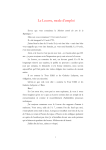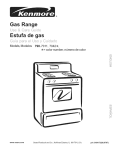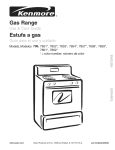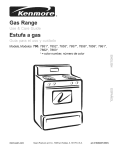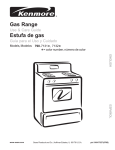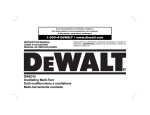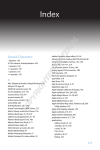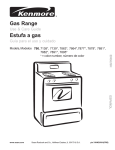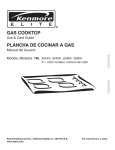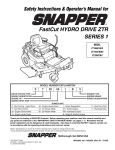Download CYCLO 5 Instruction manual
Transcript
INSTRUCTION MANUAL FOR MODEL 5, 5C & 5CE CYCLO ORBITAL POLISHER/SANDER Cyclo Toolmakers, Inc · 1740 Skyway Drive · Longmont, CO 80504 · USA INSTRUCTION MANUAL FOR MODEL 5, 5C & 5CE CYCLO ORBITAL POLISHER/SANDER This instruction manual is furnished with each Cyclo Model 5, 5C & 5CE Electric Polisher/Sander tool. The entire manual should be read carefully before using the Cyclo Polisher/Sander tool and retained for future reference. This manual contains separate sections to inform the purchaser of the tool on: #1 SAFETY INSTRUCTIONS #2 OPERATING INSTRUCTIONS #3 POLISHERS, CLEANERS & PROTECTANTS #4 USER MAINTENANCE & TROUBLESHOOTING TECHNICAL SPECIFICATIONS: Volts Cycle H.P. Model 5: 115 60 1/3 2.0 (.23kW) Model 5C & 5CE: 230 50 1/3 1.0 (.23kW) RPM: 2800 to 3200 Weight: 6.5 lbs (2.9 kg) Noise Emissions - 5CE: 82.6 dBA Vibration - 5CE (m/s2 )*: Vertical Lateral Front Handle 26.3 30.2 Rear Handle 29.9 41.9 Front-T o-Back 18.4 11.2 Motor: Alternating current, Universal, Semi-Enclosed 24-bar commutator Electric Cord: 6' long, Non-Marking, 18/3 SJT or 8' long, CEE 7/7 Housing: Heavy-duty cast aluminum Listing/Approvals: European Community - Model 5CE Testing Labs: TÜV, Components Reliability and Safety - Model 5CE • Amp Vibration testing per ISO 8662-1:1986 2 SAFETY INSTRUCTIONS WARNING: When using electric tools, basic safety precautions should always be followed to reduce the risk of fire, electric shock, and personal injury, including but not limited to the following: -READ ALL INSTRUCTIONS1) GROUNDING INSTRUCTIONS FOR MODEL 5 & 5C The Cyclo Polisher/Sander should be grounded while in use to protect the operator from electric shock. This tool is equipped with an approved three-conductor cord and three-prong grounding type plug to fit the proper grounding type receptacle. The green conductor wire in the cord is the grounding wire. NEVER CONNECT THE GREEN WIRE TO A LIVE TERMINAL. If there is any doubt as to whether the wall receptacle is properly grounded, you should have it checked by a qualified electrician. DO NOT UNDER ANY CIRCUMSTANCES CUT OR REMOVE THE THIRD (GROUND) PRONG FROM THE POWER CORD PLUG. 2) EXTENSION CORD With the Orbital Polisher/Sander, use only three-wire extension cords that have three-prong grounding type plugs and three-pole receptacles that accept the tool's plug. Replace or repair damaged cords. When using this tool at a distance from the power source, a three conductor grounding type extension cord of ADEQUATE SIZE must be used for safety and to prevent the loss of power and overheating. For the 115 Volt, 2.0 Amp tool, the figures on page 3 indicate the size of wire which must be within the indicated length of extension cord. AMPERE 2.0 (Model 5) Extension Cord Length 0-100 feet 101-250 feet Size of Wire in Cord 18 gauge 16 gauge AMPERE 1.0 (Model 5C &5CE) Extension Cord Length 0-100 feet 101-250 feet 3) Size of Wire in Cord 18 gauge 18 gauge MOTOR Your Cyclo Orbital Polisher/Sander is powered with a sturdy motor. Be certain your power supply agrees with that shown on the name plate. A.C. means alternating current. Variance in your voltage by more than 10% will mean loss of power and overheating. This tool is factory tested. If it will not operate, check electric supply for blown fuses, check plug and electrical receptacle for proper contact. ADDITIONAL SAFETY INSTRUCTIONS 1) Keep Work Area Clean. Cluttered areas and benches invite injuries. 2) Consider Work Area Environment. Don't use power tools in damp or wet locations. Keep work area well lit. Do not use the tool in the presence of flammable liquids or gases. 3) Guard Against Electrical Shock. Prevent body contact with grounded surfaces. For example: pipes, radiators, ranges. 4) Keep Children Away. Do not let visitors contact tool or extension cord. All visitors should be kept away from work area. 5) Store Idle Tools. When not in use, tools should be stored in dry, and high or locked-up places - out of reach of children. 6) Do not Force Tool. It will do the job better and safer at the rate for which it was intended. 7) Use the Right Tool. Do not force small tool or attachment to do the job of a heavy-duty tool. 8) Dress Properly. Do not wear loose clothing or jewelry. They can be caught in moving parts. Rubber gloves and non-skid footwear are recommended. Wear protective hair covering to contain long hair. 3 9) Use Safety Glasses. Always wear eye protection wh en using the tool. Also use face or dust masks if operation is dusty. 10) Do not Abuse Cord. Never carry tool by cord or yank it to disconnect from receptacle. Keep cord away from heat, oil and sharp edges. Do not force sharp bend in cord, especially where it exits the handle and particularly when curling cord for storage. 11) Secure Work. Use clamps or a vise to hold work. It is safer than using your hands and it frees both hands to operate tool. 12) Do not Overreach. Keep proper footing and balance at all times. 13) Use Proper Hearing Protection. Prolonged exposure to tool without hearing protection could promote a loss of hearing. 14) Maintain Tool with Care. Keep tool clean for better and safer performance. Follow instructions for lubricating and changing accessories. Inspect cord periodically and if damaged, have repaired by authorized Cyclo service facility. Inspect extension cords periodically and replace if damaged. Keep handles dry, clean, and free from oil and grease. 15) Disconnect Tools. When not in use, and always before servicing, or changing accessories, such as heads, sanding jackets, and bonnets, disconnect power cord from power source. 16) Remove Adjusting Keys and Wrenches. Form a habit of checking to see that adjusting wrench is removed from tool before connecting to power. 17) Avoid Unintentional Starting. Be sure switch is off when plugging in to power source. 18) Use Only Outdoor Extension Cords. Use only extension cords intended for use outdoors and so marked. 19) Stay Alert. Watch what you are doing. Use common sense. Do not operate tool while tired. Keep fingers away from moving parts at all times. 20) Check Damaged Parts. Before further use of tool, a guard or other part that is damaged should be carefully checked to determine whether it will operate properly and perform its intended function. Check for alignment of moving parts, binding of moving parts, breakage of parts, mounting, and any other condition which may affect the tools operation. A guard or other part that is damaged should be properly repaired or replaced by an authorized Cyclo service center unless otherwise indicated elsewhere in this instruction manual. Have defective switches replaced by authorized Cyclo service center. Do not use tool if switch does not turn tool on and off. 21) Insulated Handles. Do not operate the tool without the properly insulated handles. NOTE: If shrink wrap insulation on the rear metal handle is damaged or is removed at the time of repair, it must be replaced before the tool is put back into service. The proper precut length is available from Cyclo Toolmakers or your dealer. 22) Use only Cyclo Toolmakers Recommended Products. The use of any other accessories or attachments other than those recommended in the operating instructions or the catalogue may present a risk of personal injury, and could void any warranties. OPERATING INSTRUCTIONS Using the Cyclo polisher: Your Cyclo tool has two heads rather than the single head you may be accustomed to seeing. As soon as the Cyclo tool is placed on a working surface, and switched on, orbital “hand-rubbing” action takes place. Therein lies the secret of its ability to do many different types of jobs that could not be done with single head or rotary tools. The two heads move in a circular, overlapping motion and are counterweighted to balance. Thus, very little centrifugal force is exerted and the vibration, heat and throwing and pulling action of a rotary tool is eliminated. No matter how much pressure you apply to your Cyclo tool, whether you are sanding or polishing, the machine remains steady. The more pressure you apply the harder the heads work, although even, moderate or gravity-only pressure works best in most situations. The hand-like action of the counterbalanced heads prevents sur face damage, regardless of the pressure applied. Move the machine slowly; you need not be afraid of burning the surface. The polishing pads: 1) Pads are available in three different attachment methods: standard Velcro, premium Velcro and bonnets. The standard Velcro pads have loop material that extends the full diameter of the pad. The premium Velcro pads have loop material that is smaller than the full diameter of the pad. And the bonnets are rubber pad holders with a pad permanently affixed. Pad Type White Foam Finishing Pad Green Foam Polishing Pad Orange Foam Polishing and Compounding Pad Yellow Foam Cutting Pad Yellow Foam Scrubbing Pad Light Cutting White Wool Pad Standard P/N 72-110-std 72-120-std 72-125-std 72-135-std 72-160-std Premium P/N 72-110 72-120 72-125 72-135 72-160 72-455-a Bonnet P/N 71-110-a 71-120-a 71-125-a 71-135-a 71-160-a 71-455-a 4 2) In order to affix the Cyclo bonnets to the twin heads, first disconnect the power cord, then simply turn the polisher upside down and rest it in your lap. Turn the bonnet inside out and place its rubber base squarely on one of the heads. Now, grip the head and the bonnet firmly between both hands, and with the thumbs, turn the edge of the bonnet down over the head. Rotate the head slightly and repeat the step above until the bonnet’s edge is completely over the head. With the velcro pads, you install the rubber pad holder (a rubber jacket with Velcro attached) in the same manner as above. However, to change pads just peel off the used pads and attach a fresh pad by pressing it firmly in place centered on the velcro jacket. 3) The pads and bonnets should be cleaned as soon as possible after use with a good industrial cleaner or detergent in warm water. For best results, wash the foam pads out by hand, squeeze dry (do not twist or wring) and let air dry. The wool pile pads should also be washed with a good industrial cleaner or detergent and then run through with a brush. The wool pads and can also be washed in warm water and tumble dried in a cool dryer. CYCLO POLISHERS, CLEANERS & PROTECTANTS Never try to use a rotary type polish or cleaner with the Cyclo polisher and never try to use Cyclo polishes with rotary tools. The Cyclo products are specifically formulated for use with the Cyclo and though some hand application type polishes may give satisfactory results, we recommend that for the BEST results only the laboratory and field tested genuine Cyclo products be used with the Cyclo tool. 1) On painted surfaces use the CTI Pro Paint Care line or the CTI One Pass Express: CTI Pro Paint Care Line: 1. Heavy Compounding Gel – Removes scratches and heavy oxidation from surface. Very aggressive compounding polish for use on any surface. 2. Light Compounding Liquid – Great for removing hairline scratches and medium oxidation. It’s mildly aggressive and can be applied to entire painted surfaces. 3. Cleaner-Deoxidizer – Smooths and conditions the paint surface and removes light to medium oxidation, leaving the rejuvenated paint ready for polish or sealants. 4. Polish and Protective Sealant – Gives paint that lustrous shine it had when new, and gives tough-as-nails protection for up to 18 months. CTI One Pass Express: 1. 2) Cleaner-Polish-Sealant – With just one step you can do it all. Remove oxidation and scratches. Rejuvenate a dull finish. Protect the mirror shine from the elements. On unpainted aluminum or stainless steel use the CTI Metal Polish: CTI Metal Polish: 1. Free FliteTM Cleaner-Polish - With one easy step this aggressive rubbing compoun d removes corrosion, oxidation and surface film while also leaving a polished finish that is absolutely stunning. For quality that meets high government standards for its aircraft, insist on Free FliteTM Cleaner-Polish 2. Free FliteTM Protectant Sealant – Specially formulated to bond to bare metal, allowing you to deoxidize the surface and effortlessly remove polishing scratches. Plus, its protective coat helps prevent further oxidation. Polishing: 1) After you have placed the pads or bonnets on your Cyclo tool, connect the tool to the power supply. 2) Apply a small amount (about a teaspoon, or a spot the size of a dime) of the proper polish to each pad; small amounts work better than large amounts. 3) Place the twin -head Cyclo tool, pad side down on the surface and move the tool around before turning it on in order to distribute the polish within the pad and over the surface. 4) Turn on the tool and move it back and forth and side to side across an area approximately 2’ x 2’ in size. This will spread the polish or deoxidizer across the surface in a latticed pattern. 5) Grip both handles of the polisher, and using only light or moderate pressure - letting the action and the weight of the tool do the work - move the polishing heads across the area at a comfortable speed. Deoxidize or polish the entire car in this manner. When you have finished, rub out by hand the powdery residue left from the deoxidizer or smooth out any smudges left by the glaze. We recommend our white pads/bonnets, microfiber or terry covers for removing any remaining residue. 5 6) If the residue does not wipe off easily, the surface is still not clean. 7) Repeat steps 2-5 as necessary. 8) As the pads become fully impregnated with polish or oxidized paint, they should be removed and washed. Never keep polish in pads overnight. USER MAINTENANCE AND TROUBLESHOOTING Motor: Always be sure the Cyclo polisher/sander is disconnected from the electrical outlet before any inspection or maintenance is performed. The motor is only for the voltage specified on the nameplate. It is universal in that it can be used on either direct or alternating current from 25 to 60 cycles. Voltage should not vary more than 10% over or under the voltage shown on the nameplate. Although the Cyclo is built to last a lifetime it can encounter problems from heavy wear and tear. All problems are repairable, and can most often be repaired by the user. If the Cyclo tool has stopped: 1) Inspect the carbon brushes. Most likely the brushes have been worn down and need to be replaced. When replacing your carbon brushes, keep in mind that Cyclo carbon brushes have been made specifically for the Cyclo with a pre-cut contour on the front edge of the carbon block to match our commutator, a section of the motor armature, and a nylon plug has been placed in the rear of the carbon block (in front of the spring) to interrupt the electrical flow when the carbon block wears down to this point. This prevents the load spring from coming in contact with the commutator and shorting out t he entire armature. CAUTION: Be sure the power cord is disconnected. Unscrew the black brush cap found on each side of the motor housing. The carbon brush and spring can then be easily withdrawn from the motor housing. Note how the contour in the carbon block matches the contour of the motor armature. The carbon brush must be reinserted in this same pattern to maximize electrical contact with the armature. If badly worn, down to the first printed letter, call Cyclo to order new brushes. Also replace if assembly has a weak spring. Keep brushes clean and sliding freely in their guides. 2) Check the electrical supply for blown fuses and the plug and electrical receptacle for proper contact. How to maintain your Cyclo polisher/sander: 1) Every eight hours of use, lubricate the upper motor bearing by placing 3 drops of light machine oil (e.g. 3-in-1 oil) in the center of the copper bushing found at the top of the motor housing. 2) Every eight hours of use, or as conditions warrant, blow out the motor housing with an air hose to clean out any accumulated dust or dirt. If the tool is being used to clean carpets, be sure to blow out the motor housing after every use. If tool should get wet, be sure to blow out the underside of the tool. 3) Never operate the polisher with chipped or otherwise damaged brush caps. Be sure the power cord is disconnected. Using a screwdriver, remove the damaged brush cap and the carbon brush and spring, with a cotton Q-tip wipe the threads on the inside of the brush holder clean of any foreign matter, replace the carbon brush and spring and screw on a new brush cap. ANY OTHER SERVICING SHOULD BE PERFORMED BY AN AUTHORIZED CYCLO SERVICE CENTER OR THE TOOL SHOULD BE SENT TO CYCLO TOOLMAKERS, INC. Lubrication: This tool was properly lubricated at the factory and is ready to use. The gears should be inspected after approximately 400 hours of use. If necessary, relubricate with Texaco Multifax #2 or equivalent. Timing: The secret of the operation of your Cyclo polisher/sander lies in the fact that the two heads are timed exactly 1/2 turn apart. This is necessary for the balanced operation of the tool. If the machine is disassembled, use the following procedures to insure proper timing of the heads. 1) Turn the tools main case upside down, with the motor case, cover plate, and idler gear removed. Move the two heads together as close as possible. Then, put a heavy rubber band around the side of the two heads to keep them together. 2) Turn the tool right side up and carefully replace the idler gear without moving the drive gears. Now, pack the recessed well in back of the idler gear with lubricant. Also, lubricate the metal shafts in the center of each gear. 3) Reassemble the cover plate and motor case and remove the rubber band. 6 Bearings: The bearings in the counterweights will loosen slightly with continued long use. This actually improves the action of the tool by allowing the heads to tilt slightly and follow a contoured surface better. These bearings should not be considered defective until they become objectionably noisy at which time the entire polisher should be sent to an authorized Cyclo service center for repair. Heads: The twin heads of the polisher will wear out gradually with use and should be replaced when they no longer hold the polishing bonnets firmly in position. Simply turn the polisher upside down (so the twin heads are facing up), rest the polisher on a counter or on your lap. Slide a flat 5/8” wrench between the head and the counterweight. With the wrench in one hand and the head in the other, twist the head counterclockwise until the threaded shaft is completely clear of the nut. Oil the nut threads slightly and reverse the above procedure to attach new heads or brushes. Be sure to screw the head of brush straight into the counterweight nut. If the shaft seems to be screwing into the nut with difficulty, back it out and start over again. Be sure to tighten the heads or brushes snugly into the nut or the polisher will vibrate badly when in use. Cyclo Toolmakers, Inc. 6 Plus 6 Warranty Cyclo Toolmakers, Inc. warrants this machine to the original purchaser/user to be free from material or workmanship defects for a period of 6 months from the date of purchase provided the machine is delivered or shipped freight prepaid to the Cyclo Factory or a Cyclo authorized repair center. Our obligations under this warranty are expressly limited to replacement or repair of such parts as inspection shall disclose to have been defective and the labor required for installation. Conditions resulting from misuse, negligence, alterations, accidents, damage caused by improper use of chemicals, or improper repair by unauthorized parties, or “wear and tear” from normal usage, are not covered. Use of parts other than genuine Cyclo parts may void warranty. Any adjustments or replacements of defective parts made under this warranty will not void the warranty, nor will it extend the original warranty. For an additional 6 months, Cyclo agrees to share the cost of any necessary replacement part or parts by allowing the purchaser a 30% discount from list prices on part or parts replaced for a period of 6 months from the date the warranty expires. Sending Your Cyclo Polisher In For Repair q q q q q Please attach a note answering the following questions: o Is your tool unde r warranty? (Enclose proof of purchase) o Would you like an estimate, or a repair? q If you would like your tool repaired, please indicate that Cyclo has permission to make repairs costing up to $60. We can only repair your tool if you have provided us with your credit card information. For all repairs over $60, Cyclo will contact you to confirm the price before making any repairs. o What is wrong with your tool? Please include $10 for return shipping charges if your tool is not under warranty. (If paying by credit card, please provide Visa/MC number, expiration date and the cardholder name.) If your tool is not claimed within 30 days after repair quotation (when not in warranty), your tool will be disposed of. If $10 was included for return shipping, we will return the polisher to the address given. Repair labor is $45/hour. Send repairs to: Cyclo Toolmakers, Inc. ATTN: Service Dept. 1740 Skyway Drive Longmont, CO 80504 7 8 9 CYCLO TOOLMAKERS, INC. ORBITAL POLISHER - SANDER MODEL 5, 5C & 5CE Parts Price List - Effective March 1, 2005 Indicator Number Part Number Price Each Description 1 12-560-ASSY Handle, Plastic Front, Polisher (Unit of Measure = each) $ 11.90 2 50-010 Needle Bearing (unit of measure = each) $ 5.35 3 11-080 Short Shoulder Bolt for Retaining Cover Plate 4 10-020-ASSY Metal Cover Plate 5 20-190 Screw, Handle Retaining $ 0.27 6 60-010-ASSY Nylon Drive Gear, Connects to Counterweight (Unit of Measure = each) $ 11.30 7 60-020-ASSY Nylon Idler Gear (Center Gear) $ 11.30 8 10-010-ASSY Main Gear Case (Unit of Measure = each) $ 48.85 9 22-160 Washer, Star Lock Washer for Long Shoulder Bolt $ 0.18 10 20-500 Screw, Metal Housing Retaining (767) $ 0.80 11 22-520 Nut For Front Shoulder Bolt $ 0.28 12 50-040 Bearing, Main Drive Gear $ 8.85 13 20-180 Screw, Main Bearing Retaining 14 60-030-ASSY Counterweight Assembly (with bearing) 14 * 60-025-ASSY OLD STYLE Counterweight Assembly (with bearing) 15 60-055-ASSY Head Assembly (connects to 60-030 Counterweight Assembly) each) 15 * 60-050 OLD STYLE Head Assembly w/ Bearing (323-1) 16 10-040-ASSY 17 51-705 18 50-020 Bronze Bearing 19 * 19 * 30-525 Brush Holder Caps 30-520 OLD STYLE Brush Holder Caps 20 30-500 Carbon Brush, Countoured Spring, and Dead Stop 21 30-515 Carbon Brush Holder 22 21-020 Screw, Brush Holder Retaining 23 ** 23 ** 30-300 Field 115V, 60Hz 30-300-GR Field 115V, 60Hz –GR model 24 20-020 Screw, Rear Handle 25 22-010 Split Lock Washer For Field Retaining Screw 26 20-100 Screw, Field Retaining (Unit of Measure = ea) $ 0.28 27 ** 27 ** 30-200 Armature, 115V, 60Hz (Unit of Measure = ea) $ 28.80 30-200-GR Armature, 115V, 60Hz –GR model (Unit of Measure = ea) $ 60.00 28 20-080 Screw, Motor Bearing Hold $ 0.21 29 50-030 Bearing, Lower Motor $ 8.85 30 51-710 Lock Ring for Pinion Gear 31 30-000 Switch, Single Pole, Single Throw, 230V, Model 5 and 5C 32 31-800 Crimp-on Wire Connector 33 20-060 Screw, Grounding (Unit of Measure = ea) $ 0.18 34 31-000-ASSY Power Cord Assembly, U.S.A. Standard. (Unit of Measure = each) $ 10.60 34-1 31-810 Grounding Terminal $ 0.18 34-2 31-040 Bakelite Electric Cord Clip $ 0.29 (Unit of Measure = ea) (Unit of measure = each) (Unit of Measure = ea) (Unit of Measure = each) (Unit of Measure = ea) (Unit of Measure = ea) (Unit of Measure = ea) (Unit of Measure = ea) (Unit of Measure = ea) $ 1.65 $ 22.70 $ 0.21 $ 18.15 (Unit of Measure = each) $ 9.00 (Unit of Measure = each) (Unit of Measure = $ 12.85 $ 20.60 Motor Case, Models 5 or 5C (Unit of Measure = each) $ 34.00 Oiler Felt for Bronze Bearing $ 0.46 $ 2.38 $ 2.06 $ 2.83 $ 4.60 $ 4.60 (Unit of Measure = ea) (Unit of Measure = ea) (Unit of Measure = ea) (Unit of Measure = ea) (Unit of Measure = ea) (Unit of Measure = ea) (Unit of Measure = ea) (Unit of Measure = ea) (Unit of Measure = ea) (Unit of Measure = ea) (Unit of Measure = ea) (Unit of Measure = ea) (Unit of Measure = ea) (Unit of Measure = ea) (Unit of Measure = ea) (Unit of Measure = ea) 0.35 $ 28.80 $ 28.80 $ 0.27 $ 0.13 $ 0.62 (Unit of Measure = ea) $ 6.15 $ 0.35 (Unit of measure = ea) (Unit of Measure = ea) $ 10 34-3 31-030 Strain Relief, Model 5 and 5C (Unit of Measure = ea) $ 2.06 34-4 31-011 Power Cord, Raw, USA Standard $ 5.40 35 30-020 Switch, Double Pole, Single Throw, 230V, Model 5CE 36 30-030 Noise Suppression Capacitor (Unit of Measure = ea) $ 12.25 37 30-040 RFI Power Line Filter 38 31-815 Terminal, Nylon Female Quick Disconnect 40 31-825 Female Connector (Unit of Measure = ea) $ 0.56 41 ** 41 ** 30-320 Field, 230V, 50Hz (Unit of Measure = ea) $ 28.85 30-320-GR Field, 230V, 50Hz –GR model $ 28.85 42 ** 42 ** 30-220 Armature, 230V, 50Hz $ 28.85 30-220-GR Armature, 230V, 50Hz –GR model $ 60.00 43 10-045-ASSY Motor Case, Model 5CE (Unit of Measure = each) $ 57.60 44 (Unit of Measure = ea) (Unit of Measure = ea) (Unit of Measure = ea) (Unit of Measure = ea) (Unit of Measure = ea) (Unit of Measure = ea) (Unit of Measure = ea) $ 3.41 $ 21.80 $ 0.61 31-025-ASSY Power Cord Assembly, European CE Standard (Unit of Measure = each) $ 16.90 44-1 31-835 CE Grounding Terminal $ 0.46 44-2 31-040 Cord Clip $ 0.57 44-3 31-031 Strain Relief, Model 5CE 44-4 31-012 Power Cord, Raw, European CE 44-5 31-820 Terminal, Nylon Male Quick Disconnect 45 (Unit of Measure = ea) (Unit of Measure = ea) (Unit of Measure = ea) (Unit of Measure = ea) (Unit of Measure = ea) 99-900-CUT LENGTH Shrink Wrap, Rear Handle (Unit of Measure = 6 inches) $ 4.15 $ 10.15 $ 0.61 $ 5.00 11 Part Number Old Part Number 85-110-a 71-110-a Cyclo Accessory Rubber Pad Holder w/Velcro Hook (Unit of Measure = each) 85-030 White Foam Finishing Bonnet (Unit of Measure = each) White Foam Finishing Pad w/Velcro Loop (Unit of Measure = each)STANDARD 72-110-std 72-110 85-085 White Foam Finishing Pad w/Velcro Loop (Unit of Measure = each)PREMIUM 71-120-a 85-035 Green Foam Polishing Bonnet (Unit of Measure = each) Green Foam Polishing Pad w/Velcro Loop (Unit of Measure = each)STANDARD 72-120-std 72-120 85-095 Green Foam Polishing Pad w/Velcro Loop (Unit of Measure = each)PREMIUM 71-125-a Orange Foam Compounding & Polishing Bonnet (Unit of Measure = each) 72-125-std Orange Foam Compounding & Polishing Pad w/Velcro Loop (Unit of Measure = each)-STANDARD 72-125 Orange Foam Compounding & Polishing Pad w/Velcro Loop (Unit of Measure = each)-PREMIUM 71-135-a 85-040 Yellow Foam Cutting Pad w/Velcro Loop (Unit of Measure = each)STANDARD 72-135-std 72-135 Yellow Foam Cutting Bonnet (Equivalent to Former p/n 85-040) (Unit of Measure = each) 85-065 Yellow Foam Cutting Pad w/Velcro Loop (Unit of Measure = each)PREMIUM 71-160-a Yellow Foam Scrubbing Bonnet (Unit of Measure = each) 72-160-std Yellow Foam Scrubbing Pad w/Velcro Loop (Unit of Measure = each)STANDARD 72-160 Yellow Foam Scrubbing Pad w/Velcro Loop (Unit of Measure = each)PREMIUM 73-550 85-020 2004 Terry Pad Cover, Polishing (Unit of Measure = ea) 73-530 85-025 Microfiber Terry Pad Cover (Unit of Measure = ea) 74-660 85-150 Fastcut Deox Pads, 600 Grit (Unit of Measure = ea) 76-870 85-230 Scrub Brush, Stiff - Black Bristles (Unit of Measure = each) 76-840 85-240 Shampoo Brush, Soft - White Bristles (Unit of Measure = each) 76-830 85-250 76-810 85-260 Shampoo Brush, Softer - Aqua Bristles (Unit of Measure = each) Shampoo Brush, Ultra-Soft - Gray Flagged Bristles (Unit of Measure = each) 71-455-a 85-010 Light Cutting Wool Pad (Bonnet) (Unit of Measure = each) 72-455-a 85-075 Light Cutting Wool Pad (Velcro Attachment) (Unit of Measure = each) STANDARD pads have loop material extending the full diameter of pad; PREMIUM have loop material in smaller diameter than foam disc. 12












